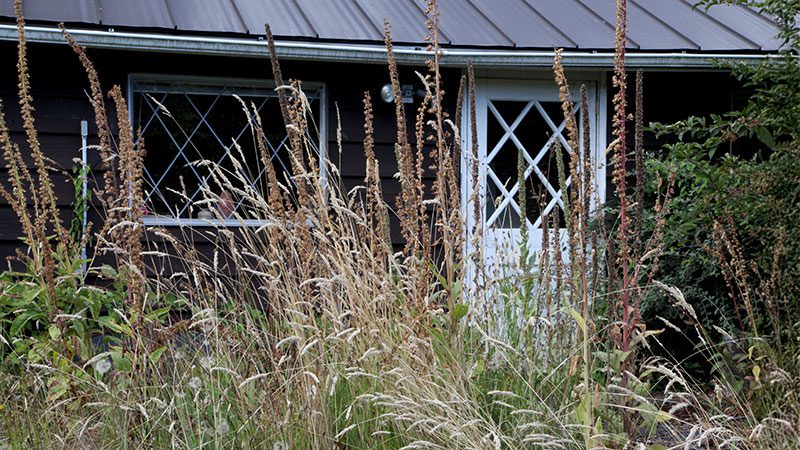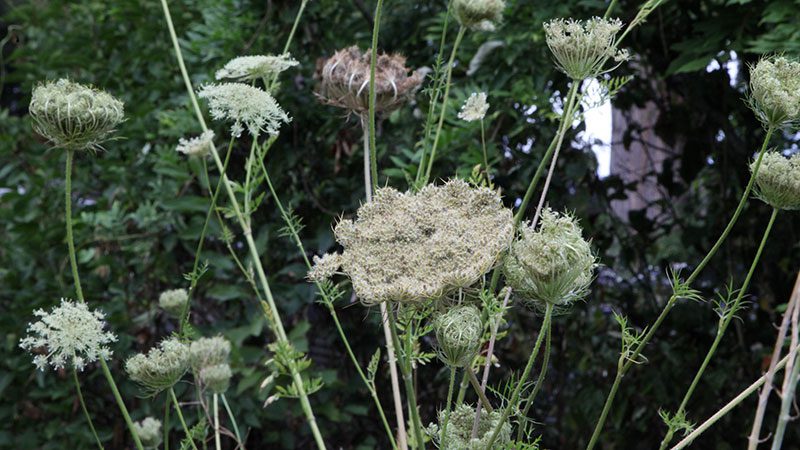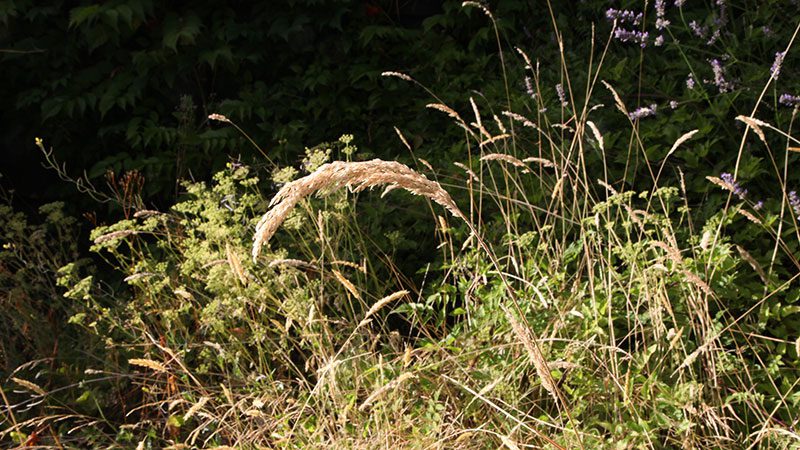Skip the fall garden cleanup and go feral
By Tara Austen Weaver, guest contributor

Photos by Tara Austen Weaver
For most gardeners, autumn means two things: harvest and fall clean up. Conventional knowledge says this is the time of year to pull out your pruners and cut back dried and dead plant matter to tidy things up for the winter.
But there is a growing movement of “feral” or “wild” gardening encouraging gardeners to skip the cleanup, at least for now. Those dried stems and spent seed heads could provide essential nourishment and habitat for a wide range of animals, from favorite songbirds to bees, butterflies, bugs, and other invertebrates. Leaving them in place through the winter months can boost the biodiversity of your garden.
Why is this important? Bees, butterflies, and other insects are pollinators—responsible for the reproduction of more than 85% of our flowering plants—and keystone species in elaborate and interconnected ecosystems. Pesticide use, loss of habitat, and climate change are taking a toll on population numbers—with US butterfly populations down by nearly 25%, over the last two decades, according to a recent study published in Science magazine.
Creating better habitat in your backyard and garden can go a long way toward supporting these pollinators, and wildlife in general. For instance, small gnats may not seem important to us, but they are an essential part of the diet of hummingbirds, so encouraging gnat growth helps support the greater ecosystem and food web.
An introduction to wild gardening
There are some simple things to avoid when encouraging biodiversity—don’t use pesticides or chemicals, limit lawn area in your garden, and avoid use of machines (lawnmowers, stemmers, and leaf blowers), as that can be damaging to wildlife and habitat. But what things can you do, proactively? Here are some simple suggestions.
Let Seed Heads Stand: Many plants and flowers have an important role to play in the garden once they are done blooming. If left in place and allowed to dry, the spent seed heads will provide food, nourishment, and occasionally habitat for a wide variety of animals. They can also add sculptural interest to the garden—and a backyard wildlife show to watch, as local birds forage for their food.
Flowers like Echinacea (coneflower), Rudbeckias (black-eyed susans), Scabiosa (pincushion flower), evening primrose, and Joe-Pye weed (Eutrochium) all provide seeds for birds like chickadees, nuthatches, blue jays, and goldfinches. Coreopsis and Sedum are also important food sources, while mullein (Verbascum), if left standing, provides overwintering habitat for insects like ladybugs.
Ornamental grasses are important contributors as well; their dried seed heads provide forage and their dense foliage offers shelter to small animals. As with all flowers and grasses, larger grouped plantings are more helpful than single plants scattered throughout the garden.

Leave the Leaves: One of the easiest things you can do to create wildlife habitat is to not dispose of fallen leaves. The majority of butterflies and moths find shelter or lay their eggs in leaf litter, which also provides protection, habitat, and food for worms, mites, beetles, spiders, millipedes, and more. These tiny invertebrates are a food source for birds and amphibians and an essential link in the larger food web.
You may want to clear leaves from essential garden areas—like paths and lawn (though research shows a thin layer of leaf matter helps enrich soil and nourish lawns). But rather than putting downed leaves in your yard waste bin, put them to use elsewhere in the garden. Pile dry leaves around the base of trees or use them as mulch on top of flower and vegetable beds, where they will retain moisture, suppress weeds, and provide organic matter and nutrients for the soil. Opt for raking leaves, rather than blowing or mowing, and if you plan to use them only in winter and remove in spring, try to wait as long as possible. This gives overwintering wildlife, like butterflies and queen bumble bees, a chance to emerge in the warming temperatures.
Save The Stems: Though cutting back plants like raspberry, elderberry, or goldenrod is a common cold season chore, numerous cavity-nesting insects use these hollow or pithy stems to overwinter or host their eggs. If possible, consider letting the stems stand—or just cut them down slightly, to give carpenter bees, yellow-faced bees, and leaf-cutter bees—among many others—ample habitat to create their nests. Smaller insects favor bee balm, native thistle, purple coneflowers, and Joe-Pye weed.
If you choose to cut these stems down—partially or completely—you can still provide habitat by bundling the stems and leaving them in sheltered areas around your garden, either horizontally or vertically. This provides additional nesting areas while preserving a tidier appearance.
Create Habitat: As most kids know, creating brush piles is fun. Scientists know that doing so also provides habitat and food for a variety of wood-eating beetles and other organisms that will, over time, break down the branches into an excellent soil additive.
Gather your materials—branches, sticks, twigs, and dried leaves—in a garden spot that is out of the way and won’t often be disturbed. The most basic version of creating wildlife habitat is to start with the biggest pieces of wood at the bottom, to provide a sturdy foundation, and to build upward with successively smaller pieces until all the materials is used up. Stuff dried leaves into the space between the branches, making sure not to pack it in so tightly there is no room for the insects and birds that will come to forage and nest.
You can get creative with your brush piles and use them as the basis for a hugelkultur bed, which uses the decomposing wood as way to feed garden beds to grow crops. Another inventive use for twigs and stalks is to make a “brush fence,” by pounding in a parallel row of tall stakes and piling up the brush between them to form a barrier that is attractive, functional, and also provides homes for wildlife.
Dry stone walls and rockpiles are other, more permanent, ways of providing habitat for small creatures and increasing the biodiversity of your garden. If building one, include a variety of rock types and use a loose configuration, which allows for air spaces of different sizes. Incorporating native grasses and wildflowers nearby will attract pollinators and birds.

Ask yourself: Do you need to remove a dead tree? If a tree dies in a garden, must it be taken down? Dead trees—also called “snags”—are a valuable resource and source of food. If it is possible to keep a snag standing, if it won’t cause damage to anything when it eventually falls, it’s recommended to do so. This sort of deadwood attracts woodpeckers, owls, and beetles, who create habitat for a variety of native bees to nest and lay eggs.
Fallen logs, if left in the garden to decompose, play a different version of the same role. You can bring some in if there is no deadwood to be had on site in your yard (hardwood logs with the bark still attached is preferred; do not bring in wood that was felled due to infection or disease). Logs can be “planted” horizontally, with one end buried a few inches into the soil to connect with moisture. It’s recommended to surround the log with smaller branches of rocks to create extra habitat and protection for invertebrates.
With a little effort—though skipping fall garden cleanup is often a case of less effort—you are likely to see significant results. I’ve skipped garden cleanup for three years now—part of a larger effort to “rewild” my suburban Seattle yard. In that time I’ve noticed 40% more bird life and a massive increase in pollination rates for fruit trees. The potted lemon tree that never produced more than 5-7 fruits a year currently has 37 lemons on it. Doing less is providing me—and the larger ecosystem—with a lot more.
This season, consider putting the pruners aside and finding some deadwood and stones for rockpiles. Your garden—and all the wildlife in it—is likely to thank you for giving it a rest.
Tara Austen Weaver is a Seattle-based writer, editor, and tender of an increasingly wild garden. She is author of numerous books, most recently How to Grow Berries and Fruit Trees in the Pacific Northwest and the Little Book of Flowers series: Peonies, Dahlias, and Tulips.
